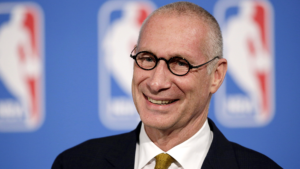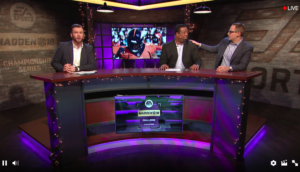The Game Behind the Games: ESPN's Big Week at a Crucial Time for Sports Rights
Late December television on ESPN and other sports channels is usually filled with football, with dozens of college bowl games and the crucial last couple of weeks of the NFL's regular season.Far more interesting than many of the games, however, are the matchups behind the screens between a group of veterans and several big-shouldered newcomers. It's particularly interesting to see what's happening right now at ESPN. "The Worldwide Leader in Sports" has been slogging through a month for the ages, filled with lots of big, complicated news.ESPN is just one of the players, which also include incumbents such as Comcast/NBC, Disney/ABC, CBS and Fox and tech giants such as Amazon, Verizon, AT&T, Facebook and Apple. All these players want a pricey piece of some of the last remaining must-watch-now content out there: live sports.In the near term, at least, ESPN and the others will face an even more expensive and competitive battle for media rights, as audiences fracture across more distribution platforms and programming gets more granular, tech-enabled and personal.Live sports is “one of the primary motivators keeping people connected to the cord” for now, though maybe not forever, the consulting firm PwC suggested in its most recent annual report. PwC's survey suggested a whopping 82 percent of sports fans surveyed said they would end or trim their pay-TV subscription if they no longer needed it for live sports. About 11 percent more sports fans than non-sports fans subscribe to pay-TV services, so sports are an important driver of subscriptions too. Nowhere have the questions and challenges been bigger than on ESPN, both the long-dominant sports TV franchise and the one undergoing massive and painful public changes amid industry-wide cord-cutting woes. Just since Thanksgiving, the Disney-owned cable giant:
- Had its second round of layoffs in the year, a reported 100 mostly digital and production employees who comprised about 2 percent of the workforce. Another 150, including many on-camera personalities, were laid off in April.
- Saw its highly regarded president, John Skipper, resign, to deal with what was termed a "long-term problem with substance addiction." Former ESPN President George Bodenheimer was named temporary president. Given that Skipper had been at several public events and interacting on business issues only a couple of days before his departure, many at the network and beyond questioned what truly led to his exit.
- Became the likely flagship for 22 regional sports networks to be acquired through Disney's purchase of much of 21st Century Fox. The $52.4 billion deal doesn't include FS1, Fox's national sports network, most likely because of antitrust considerations.
- Continued preparations for an early 2018 debut of the ESPN over-the-top streaming-video app, abetted by BAMTech Media, of which Disney is now majority owner after dropping nearly $3 billion earlier this year. Of note: the long-time head of BAMTech, Bob Bowman, was pushed out earlier this fall, the Wall Street Journal just reported, "after years of troubling workplace behavior."
- With Comcast, extended its rights so it can show NFL game content across all platforms. Verizon had for the past several years owned exclusive mobile rights for NFL games, showing the streams to only its own subscribers, for free. Verizon signed a $2 billion, five-year deal that included non-exclusive multiplatform rights to NFL content, while ESPN and Comcast grabbed their share of those mobile game rights.
Other than the layoffs, most of that news came down just in the last week. Busy, busy. Skipper's departure puzzled many, who didn't quite buy the official reason for his exit. Regardless, whomever succeeds Skipper (the search for his permanent replacement is underway) will face a much more complicated and difficult job.That person will have integrate the regional networks, evolve the company's workforce for the digital era, and transition the network from a largely impregnable position in ad-fueled Pay-TV to one tussling in the highly competitive and fluid OTT subscription apps business. As all this is going on, the company must also also protect its still huge Pay-TV position.The job will be further complicated by the fiscal demands of a string of expensive rights deals with the NFL, Major League Baseball, the NBA, college sports and more. The expense of those long-term rights has been blamed for this year's layoffs, straitjacketing managers trying to deal with the effects of Pay-TV cord-cutting.And new competitors are jumping in quickly. Amazon streamed 10 Thursday night NFL games this fall to its Prime subscribers, and just last week began streaming games from the NBA's minor league operation, the G League, on its Twitch.TV subsidiary.
Skipper's departure puzzled many, who didn't quite buy the official reason for his exit. Regardless, whomever succeeds Skipper (the search for his permanent replacement is underway) will face a much more complicated and difficult job.That person will have integrate the regional networks, evolve the company's workforce for the digital era, and transition the network from a largely impregnable position in ad-fueled Pay-TV to one tussling in the highly competitive and fluid OTT subscription apps business. As all this is going on, the company must also also protect its still huge Pay-TV position.The job will be further complicated by the fiscal demands of a string of expensive rights deals with the NFL, Major League Baseball, the NBA, college sports and more. The expense of those long-term rights has been blamed for this year's layoffs, straitjacketing managers trying to deal with the effects of Pay-TV cord-cutting.And new competitors are jumping in quickly. Amazon streamed 10 Thursday night NFL games this fall to its Prime subscribers, and just last week began streaming games from the NBA's minor league operation, the G League, on its Twitch.TV subsidiary. Twitch is already home to countless video-game versions of the NFL, NBA, FIFA and other sports, including this week's Madden NFL Challenge 2018, an eight-player tournament with a $150,000 prize pool whose games were webcast live. The line between game and video game will only get more blurred as Amazon acquires more sports content.The irony for Skipper's successor and for all that person's competitors-to-be is that pricey rights, which led to so many ESPN layoffs, are exactly what everyone in the business must now acquire if they want to attract viewers in the complicated future just ahead.Given all the increased competition, combined with the complexity of providing sports on multiple video platforms, in both ad- and subscription-based modules, it's reasonable to expect those rights deals won't be getting cheaper anytime soon. Managing their delivery while still making a profit will be a challenge for everyone, not just ESPN's new Skipper.
Twitch is already home to countless video-game versions of the NFL, NBA, FIFA and other sports, including this week's Madden NFL Challenge 2018, an eight-player tournament with a $150,000 prize pool whose games were webcast live. The line between game and video game will only get more blurred as Amazon acquires more sports content.The irony for Skipper's successor and for all that person's competitors-to-be is that pricey rights, which led to so many ESPN layoffs, are exactly what everyone in the business must now acquire if they want to attract viewers in the complicated future just ahead.Given all the increased competition, combined with the complexity of providing sports on multiple video platforms, in both ad- and subscription-based modules, it's reasonable to expect those rights deals won't be getting cheaper anytime soon. Managing their delivery while still making a profit will be a challenge for everyone, not just ESPN's new Skipper.